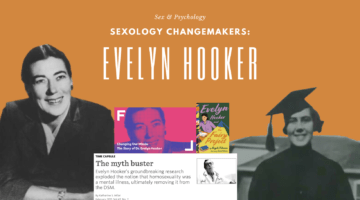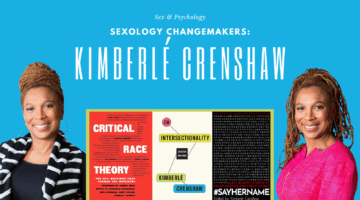How Gay Men and Lesbians Respond to Offers of Casual Sex
May 19, 2021 by Justin Lehmiller
A lot of research has examined how men and women respond to proposals for casual sex; however, the bulk of this research has focused on people who are heterosexual. This research points to a large gender difference, with heterosexual men being far more likely to accept offers of casual sex than heterosexual women.
For example, in a famous study published in the 1980s, research assistants wandered around a college campus and propositioned people of the other sex. Whereas about three-quarters of the men said yes when offered sex by a female stranger, not a single woman said yes when offered sex by a male stranger (you can learn more about this study here and see a video of a modern-day replication).
But what happens when you look at gay men vs. lesbians instead? Is there still a large difference? A recent set of studies published in the Archives of Sexual Behavior sought to find out.
The researchers predicted that there wouldn’t be a difference between lesbian women and gay men when offered casual sex because “lesbian and gay people follow unique romantic and sexual scripts in their communities…and lesbian women and gay men have similar experiences of pleasure in same-gender encounters.”
It has been well documented that the orgasm gap really only exists in sexual encounters between men and women, with women being substantially less likely to experience orgasm than men (especially during casual sex). By contrast, rates of orgasm are similarly high in same-gender encounters. It has been argued that women’s lower anticipation of pleasure contributes to a lower rate of willingness to pursue casual sex with men—however, when women are offered casual sex by other women, this lower expectation of pleasure is less likely to be present.
In two different studies, gay men and lesbians were asked to reflect on and answer questions about the most recent offer of casual sex that they received (the sample sizes were 465 and 487, respectively). Some of the questions varied across surveys and many different aspects of casual sex were examined; however, for purposes of this post, I will focus mostly on acceptance rates.
In both studies, the results were contrary to the prediction that no gender difference would be observed, with gay men being significantly more likely to accept their most recent offer of casual sex than lesbian women (71% vs. 54% in the first study and 76% vs. 62% in the second study).
However, it’s notable that in both studies, a majority of lesbians said they accepted the offer of casual sex. Also, while the gender difference was sizable, it’s nowhere near the size that has been observed in some studies comparing heterosexual men and women (such as the study mentioned at the top of this post).
A few other findings of note:
· In both studies, there was no gender difference with respect to how gay men and lesbians evaluated the sexual capabilities of the casual sex proposer. Thus, they seemed to anticipate similarly high levels of pleasure. Also, it’s worth noting that as perceived sexual capability increased, so did likelihood of accepting the offer.
· In the second study, they looked at acceptance of casual sex offers in a finer level of detail, exploring the sexual orientation of the proposer. They found that gay men were more likely than lesbians to accept offers from someone who was “straight but curious” (80% vs. 52%, respectively), whereas there was no gender difference in acceptance of offers from bisexual proposers (73% vs. 77%, respectively).
· The second study also found that gay men reported similarly high acceptance rates regardless of the proposer’s sexual orientation, whereas lesbian women had lower rates of acceptance for the “straight but curious” proposers compared to lesbian and bisexual proposers.
· In the second study, gay and lesbian proposers were seen as being more sexually capable than the “straight but curious” proposers—but this was especially true among lesbians, which may explain why lesbians were less likely to accept offers of casual sex from this group.
· In the second study, lesbians reported perceiving more stigma from casual sex than did gay men, which statistically accounted for why lesbians reported lower rates of acceptance than did gay men.
This research is limited in that it does not reflect a representative sample of the gay and lesbian community. It also doesn’t tell us anything about the frequency, manner, or circumstances under which these groups receive offers of casual sex, which is something that would be useful to explore in future work.
That said, these results suggest a few important conclusions. One is that gay men and lesbians seem to be more similar in their acceptance of offers of casual sex compared to heterosexual men and women. Further, gay men and lesbians both appear to perceive casual sex partners as equally capable of bringing them pleasure. However, casual sex appears to be more of a taboo for women in general (regardless of their sexual orientation), which may explain why women overall are less likely to accept offers of casual sex than men.
Want to learn more about Sex and Psychology? Click here for more from the blog or here to listen to the podcast. Follow Sex and Psychology on Facebook, Twitter (@JustinLehmiller), or Reddit to receive updates. You can also follow Dr. Lehmiller on YouTube and Instagram.
To learn more about this research, see: Matsick, J. L., Kruk, M., Conley, T. D., Moors, A. C., & Ziegler, A. (2021). Gender Similarities and Differences in Casual Sex Acceptance Among Lesbian Women and Gay Men. Archives of Sexual Behavior, 50(3), 1151-1166.
Image Source: 123RF/mavoimage

Dr. Justin Lehmiller
Founder & Owner of Sex and PsychologyDr. Justin Lehmiller is a social psychologist and Research Fellow at The Kinsey Institute. He runs the Sex and Psychology blog and podcast and is author of the popular book Tell Me What You Want. Dr. Lehmiller is an award-winning educator, and a prolific researcher who has published more than 50 academic works.
Read full bio >


